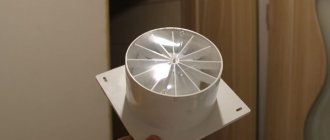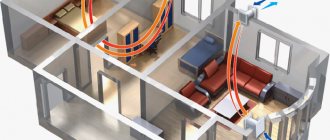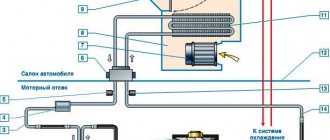Nowadays, it is impossible to imagine your life without ventilation systems. They are installed in industrial buildings, offices, educational institutions, shops, and apartments. The operation of these systems is unthinkable without the use of exhaust fans of various capacities. A widespread element of apartment ventilation is the kitchen hood. It can have different shapes, sizes, designs.
The amount of purified air in the room will depend on the calculation of the power of the kitchen hood fan.
Exhaust ventilation in the kitchen
But external beauty is not the most important thing. The main task of this device is to rid the kitchen of odors, burning, soot and grease that appear during cooking. Exhaust ventilation removes fumes emanating from various types of heating devices. It prevents the appearance of dirty deposits on the ceiling and wall surfaces. This allows you to perform cosmetic repairs much less frequently, which will save a significant amount of money. It will also take less time to carry out general cleaning.
A device capable of passing a certain amount of air through its filters can cope with the task of cleaning the atmosphere in a room. And for this you need to select a device with a fan of the required power. How to calculate the power of a device?
Specifications. Productivity, pressure, power
Machines used for industrial purposes to move various liquids and air-gas mixtures are similar in design. Therefore, they have identical basic technical operating parameters.
Depending on the area of application and operating conditions, a wide range of ventilation machines are produced, the choice of which consists in determining the main technical parameters such as:
1. Productivity Q – determines the amount of air-gas mixture moved per unit of time. Fan performance can vary from 1 to 1,000,000 m 3 /s. Calculated as follows:
where: V is the volume of the moving flow of the working medium [m 3 ]; t – time.
2. Pressure – represents the amount of energy transferred to the moving air-gas medium as it passes through the fan. Fan pressure is usually expressed in terms of pressure units. The total pressure created by the fan consists of static and dynamic components:
where: Рп – total pressure [Pa]; Pst – static pressure [Pa]; Рdin – dynamic pressure (Рdin = ρω 2 /2) [Pa]; ω – average speed of the working medium [m/s]; ρ – density of the working medium [kg/m3].
3. Power characterizes the amount of energy required to move the working medium. They are divided into useful and useful. Input power is the energy transferred from the drive to the fan, and useful power reflects the actual energy consumed to move the working fluid. The value of the supplied power is greater than the useful one, this is explained by various losses during energy transfer.
The fan power is determined from the following expression:
where: Q – fan performance [m 3 /s]; P – pressure created by the fan [Pa]; ŋ – fan efficiency.
4. Along with the above-mentioned main technological parameters of fans, the following secondary indicators play an important role: climatic design, permissible noise level during operation, overall dimensions, corrosion resistance and others. These characteristics have a significant impact when choosing fans.
Fan power calculation
To calculate the fan power, you need to do the following:
An example of calculating the performance of a kitchen hood fan.
- Using a tape measure, measure the size of the kitchen and determine its volume in meters. To do this, the length must be multiplied by the width and height. The BTI documents indicate the area of the premises. Example: the area of the kitchen area is 10 m². The height from floor to ceiling is 3 m. We multiply the area by the height and get 30 m³. This is the size of the kitchen.
- Next, the value characterizing air exchange is calculated. To do this, you need to multiply the volume of the kitchen by the number of complete air updates per hour. Building codes and regulations (SNiP) provide for an air exchange rate of 10-12. Thus, to calculate the capacity of the exhaust system, you need to multiply 30 m³ by 12. The result is a figure of 360 m³/hour. This much air must be renewed every hour.
- To carry out exchange in such a volume, you need a fan with a power of 400-800 m³/hour. But standard ventilation ducts can only pass about 180 m³. Therefore, a fan will not help much here.
- In this case, a recirculating exhaust system will help, which passes air through filters and sends it back into the room. Overcoming the resistance of the filters also requires power. Therefore, 40% should be added to the calculated figure. The result will be 560-1120 m³. This should be the power of the hood fan in a kitchen measuring 30 m³.
- In some cases, you can do without a ventilation duct. To do this, the exhaust fan is installed in a specially equipped opening in the wall, in the ceiling or at the junction of the ceiling and wall. This installation allows the use of a less powerful fan.
Exhaust power for different rooms.
This is just a simple calculation of the required exhaust fan power. If the kitchen does not have doors, then you also need to take into account the volume of the adjacent room. So, the formula for calculating fan power for general cases is: room width x length x height x exchange rate = required value. You can calculate the volume of the room without any problems. It is enough to measure the length, width and height and multiply them.
How to increase fan performance
The presence of fresh air in the premises is the key to good work and excellent well-being of all household members. This can be organized by installing fan equipment in the room that can evenly cool the room. At the same time, its quiet operation, which does not create discomfort for others, is important.
It is desirable to create an unimpeded flow of air from the ceiling to the floor, which could be freely distributed around the entire perimeter of the room. Thanks to this, the device will heat up less and its performance will increase.
From a school physics course we know that cold air occupies the bottom of the room, and hot air occupies the top. Therefore, it is recommended to install an air outflow at the bottom of the room. The presence of active air outflow and inflow requires the installation of exhaust/injection fans of equal performance.
Ventilation system
You can increase the performance of the fan by switching it to efficient operation mode. In this case, the operation of the device should be minimal when household members are not at home. In other situations, it is recommended to increase the air supply in the room where people are. If there is an active cooking process in the kitchen and the shower is running for a long time, it is recommended to increase the local air supply in these rooms to the maximum. Such “smart” ventilation can quickly and efficiently exchange air in any room.
For the described ventilation system, a special control unit is equipped, which is connected to the processor. Sensors that can detect:
- degree of movement;
- amount of carbon dioxide;
- relative air humidity.
Responsible for the selected operating mode is the “control unit”, which sets the operating mode for the exhaust pumps. These devices can serve one or several rooms. The number of such devices depends on the area of the room. The hood from the kitchen is also connected here.
Kitchen hood
The advantage of using the described “smart” ventilation system is the correct regulation of the performance of exhaust fans, allowing you to reduce the amount of air pumped over 24 hours by almost half. It also consumes less electricity, which is a big plus for family budgets.
Air change rate
The multiplicity for premises of different types is determined as follows:
| Room type | Multiplicity |
| Bakery | 20-30 |
| Greenhouse | 25-50 |
| Office | 6-8 |
| Bathroom, shower | 3-8 |
| Salon | 10-15 |
| Restaurant, bar | 6-10 |
| Bedroom | 2-4 |
| Lobby | 3-5 |
| Classroom at school | 2-3 |
| Cafeteria | 10-12 |
| A hospital room | 4-6 |
| Shop | 8-10 |
| Basement | 8-12 |
| Kitchen in a house or apartment | 10-15 |
| Gym | 6-8 |
| Attic space | 3-10 |
| Catering kitchen | 15-20 |
| Pantry | 3-6 |
| Changing room with shower | 15-20 |
| Laundry | 10-15 |
| Toilet in the house, in the apartment | 3-10 |
| Conference hall | 8-12 |
| Living room | 3-6 |
| Billiard room | 6-8 |
| Public toilet | 10-15 |
| Garage | 6-8 |
| Meeting room | 4-8 |
| Utility room | 15-20 |
| Library | 3-4 |
| Dining room | 8-12 |
Table for calculating the minimum performance of the hood relative to the volume of the kitchen.
The highest multiplicity is chosen for use in rooms with many people, high humidity and temperature, a lot of dust and strong odors. In a kitchen with an electric hob, you can choose a lower indicator, with a gas stove - a higher one. This is due to the fact that gas emits combustion products when the stove is turned on. The fan, selected taking into account the above data, can be mounted in a wall, window, or ceiling of the room.
Standards and requirements for room ventilation
According to SNiP requirements, for residential buildings the required fan performance is calculated based on the air exchange rate. Each household premises has its own standards:
- combined bathroom - at least 50 m³/h;
- bathroom and toilet – from 25 m³/h;
- kitchen – 60-90 m³/h;
- other premises 3 m³/h.
Taking into account the calculated frequency of renewal of the air mixture and the cubic capacity of the room, the required overall performance of the ventilation system is determined.
Types, classification of industrial fans
The general classification of fans is carried out according to the direction of movement of the flow of the moving working medium. According to it, there are two main types of fans used for industrial purposes:
In axial fans, as the name suggests, the flow of the working fluid moves along the center line or shaft of the fan.
In radial fans, the working medium moves along the blades from the center of the impeller to the edge, due to the centrifugal force arising during rotation, then along the spiral housing it exits through the discharge pipe.
PRESSURE AND SECTION
The pressure and, accordingly, the speed of movement of air masses is affected by the cross-sectional area of the channels, as well as their configuration, the power of the electric fan and the number of transitions.
When calculating the diameter of the channels, the following values are empirically taken:
- For residential premises – 5.5 sq.cm. per 1 sq.m. area.
- For a garage and other industrial premises - 17.5 sq.cm. per 1 sq.m.
In this case, a flow speed of 2.4 – 4.2 m/sec is achieved.
Comparison of radial and axial fans
The operation of axial and radial fans is based on different operating principles. In an axial fan, the flow of the working medium moves from the inlet to the outlet pipe along the shaft axis, and in a radial fan, the flow from the inlet pipe moves along the shaft axis and then, changing direction, moves to the outlet pipe perpendicular to the axis.
Centrifugal fans are most widely used in industrial processes due to the large number of modifications and applications. They are capable of operating over a wide range of capacities and pressures created. However, the design of a radial fan is more bulky and requires a large area for installation.
Axial fans are distinguished by their simplicity of design, small overall dimensions, as well as efficiency and the ability to move large volumes of working fluid over short distances. Quite often, the axial fan drive is located inside the housing, which imposes restrictions on the working environment in terms of dust content and permissible temperature. The rotation speed of the impeller of axial fans is higher than that of radial fans. This feature makes them noisier.
Source
How to calculate ventilation in the bathroom?
Productivity is calculated using the following formula: the volume of the room (length, width and height), multiplied by the air exchange rate (for a bathroom, approximately from 4 to 8). For example, for a bathroom with an area of 2x2.5 m and a ceiling height of 2.7 m, the volume of the room is 13.5 cubic meters. m. Multiply by 4 and 8.
Interesting materials:
How to launch Disk Utility when Mac boots up? How to run Dota with standard settings? How to make money by watching Tik Tok? How to register a bathhouse? How to register an individual entrepreneur not at the place of registration? How to register an invention? How to register a red and white card? How to register an organization in Yesia? How to register a schoolchild for government services? How to register your invention?
PHYSICAL COMPONENTS OF CALCULATIONS
According to the method of operation, ventilation circuits are currently divided into:
- Exhaust. To remove used air.
- Inlet. To let in clean air.
- Recuperative. Supply and exhaust. Remove the used one and bring in a clean one.
In the modern world, ventilation schemes include various additional equipment:
- Devices for heating or cooling supplied air.
- Filters for purifying odors and impurities.
- Devices for humidification and air distribution throughout rooms.
When calculating ventilation, the following values are taken into account:
- Air consumption in cubic meters/hour.
- Pressure in air channels in atmospheres.
- Heater power in kW.
- Cross-sectional area of air channels in sq. cm.











